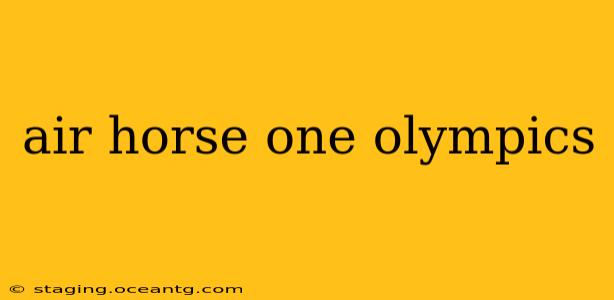The term "Air Horse One" isn't an official designation like "Air Force One," but it perfectly captures the spirit of equestrian events at the Olympic Games. It evokes the image of powerful, graceful horses soaring through the air, embodying athleticism, precision, and the unwavering bond between horse and rider. This article delves into the world of equestrian sports at the Olympics, exploring the history, the disciplines, and the incredible dedication required to compete at this prestigious level.
What are the equestrian events at the Olympics?
The Olympic equestrian program showcases the pinnacle of equestrian skill and horsemanship. Currently, there are three core disciplines:
-
Dressage: This discipline emphasizes the horse's obedience, suppleness, and the rider's ability to execute precise movements. Judges assess the harmony and elegance of the horse and rider partnership. Think of it as a ballet on horseback.
-
Eventing: Often considered the "ultimate test of horse and rider," eventing combines three demanding phases: dressage, cross-country (an intense obstacle course), and show jumping. This requires incredible versatility and stamina from both horse and rider.
-
Jumping: This is arguably the most visually spectacular equestrian discipline. Riders navigate a course of obstacles, aiming for a clear round (no knocked-down rails) in the fastest possible time. It demands incredible precision, speed, and nerve.
These three disciplines provide a diverse and captivating showcase of equestrian talent, highlighting the unique partnership and exceptional athleticism between horse and rider.
How are the horses selected for the Olympics?
The selection process for Olympic horses is rigorous and multifaceted. It's not just about the horse's athletic ability but also its temperament, health, and suitability for the specific discipline. National federations have their own selection criteria, often involving extensive training, trials, and competitions throughout the qualifying period. The horses are typically highly trained and experienced competitors, representing years of dedication from both the horse and rider.
What is the history of equestrian events in the Olympics?
Equestrian sports have been a part of the modern Olympic Games since the very beginning in 1896. While the exact disciplines have evolved over time, the core emphasis on horsemanship and athleticism has remained constant. The early games featured more military-style events, but the program has since evolved to focus on the precision and elegance showcased in today's events. The inclusion of equestrian events reflects the historical significance of horses and their role in various societies.
Are there different levels of competition in Olympic equestrian events?
While the Olympics represent the highest level of competition, there's a clear progression of events leading up to it. Riders and their horses participate in numerous national and international competitions, accumulating points and rankings that contribute to Olympic qualification. This tiered system ensures only the most skilled and well-trained partnerships make it to the Olympic stage.
What makes Olympic equestrian events so special?
The Olympic Games provide a unique platform for equestrian athletes to showcase their skills on a global stage. The atmosphere, the pressure, and the level of competition make the Olympic equestrian events truly exceptional. The dedication required, from years of training to meticulous horse care, truly sets these athletes apart. It's a testament to the strength, skill, and unwavering partnership between human and animal.
The Future of Equestrian Sports in the Olympics
The future of Olympic equestrian events looks bright, with ongoing efforts to promote sustainability and animal welfare. Innovations in equestrian technology, training, and veterinary care continue to enhance the safety and performance of both horse and rider. The evolution of the sport promises to keep it engaging and relevant for generations to come. "Air Horse One" will continue to soar, representing the pinnacle of equestrian achievement.
